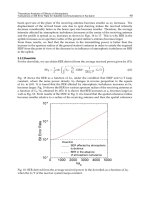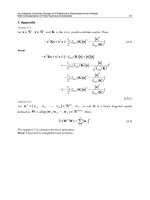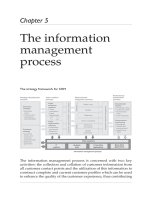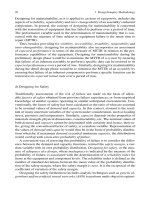Current practice guidelines in primary care - part 5 pot
Bạn đang xem bản rút gọn của tài liệu. Xem và tải ngay bản đầy đủ của tài liệu tại đây (159.91 KB, 23 trang )
80 DISEASE SCREENING: SYPHILIS
Disease
Screening Organization Date Population Recommendations Comments Source
Syphilis AAFP
USPSTF
2007
2004
Pregnant
women
Strongly recommends
screening all pregnant
women.
1. All reactive nontreponemal tests should be confirmed
with a more specific treponemal test (eg, FTA-ABS).
2. Sensitivity of nontreponemal tests varies with levels
of antibodies: 62%–76% in early primary syphilis,
100% during secondary syphilis, and 70% in untreated
late syphilis. In late syphilis, previously reactive results
revert to nonreactive in 25% of patients.
3. Specificity of nontreponemal tests is 75%–85% in
persons with preexisting diseases or conditions (eg,
collagen vascular diseases, injection drug use, advanced
malignancy, pregnancy, malaria, tuberculosis, viral and
rickettsial diseases) and 100% in persons without
preexisting diseases or conditions.
4. Between 2000 and 2003, syphilis cases increased 60%
in men and decreased 53% in women. About two-thirds
of syphilis cases in 2003 were among men having sex
with men. (Am J Public Health 2007;97:1076)
/>exam
/>clinic/uspstf/
uspssyph.htm
SYPHILIS
AAFP
USPSTF
2007
2004
Persons at
increased
risk
a,b
Strongly recommends
screening high-risk
persons.
/>exam
/>clinic/uspstf/
uspssyph.htm
AAN 2001 Patients
with
dementia
Do not screen unless
clinical suspicion of
neurosyphilis is present.
Neurology 2001;56:
1143
/>professionals/
practice/guidelines/
pda/Dementia_
diagnosis.pdf
a
High risk includes commercial sex workers, persons who exchange sex for money or drugs, persons with other STDs (including HIV), and sexual contacts of persons with
active syphilis.
b
Recommends against screening asymptomatic persons not at increased risk for syphilis infection.
DISEASE SCREENING: THYROID DISEASE 81
Disease
Screening Organization Date Population Recommendations Comments Source
Thyroid
Disease
AAFP
USPSTF
2007
2004
Adults Insufficient evidence to
recommend for or against
routine screening for
thyroid disease.
1. Individuals with symptoms and signs potentially
attributable to thyroid dysfunction
b
and those
with risk factors for its development
c
may require
more frequent TSH testing.
2. When there is suspicion of pituitary or hypotha-
lamic disease, the serum FT4 concentration
should be measured in addition to the serum TSH.
3. Controversy exists regarding Rx benefit for pa-
tients with subclinical hypothyroidism (elevated
TSH; normal free thyroxine).
4. RCT shows that treatment of subclinical hy-
pothyroidism improves cardiovascular risk fac-
tors, but has small/no effect on patient-centered
outcomes over 3 month period. TSH level did not
predict treatment response. (J Clin Endocrinol
Metab 2007;92:1715)
/>online/en/home/clinical/
exam.html
/>clinic/uspstf/uspsthyr.
htm
Ann Intern Med
2004;140:125–127
THYROID DISEASE
ATA 2000 Women aged
≥ 35 years
Screen with serum TSH at
age 35 years, and every 5
years thereafter.
a
Arch Intern Med
2000;160:1573
/>professionals/publications/
guidelines.html
AACE 2002 Elderly Periodic screening with
sensitive TSH.
a
/>pub/guidelines
Endocr Pract 2002;8:
457–469
a
A consensus conference with representatives of ATA and AACE concluded that there is insufficient evidence to support population-based screening, but that aggressive case
finding is appropriate in pregnant women, women aged > 60 years, and others at high risk for thyroid dysfunction. (JAMA 2004;291:228)
b
Signs, symptoms, and comorbidities suggestive of hypothyroidism include previous thyroid dysfunction, goiter, surgery, or radiotherapy affecting the thyroid, diabetes
mellitus, vitiligo, pernicious anemia, leukotrichia (prematurely gray hair), and medications [such as lithium carbonate and iodine-containing compounds (eg, amiodarone,
radiocontrast agents, expectorants containing potassium iodide, and kelp)].
c
Risk factors include family history of thyroid disease, or personal history of pernicious anemia, diabetes mellitus, and primary adrenal insufficiency. Laboratory test results
suggestive of thyroid disease include hypercholesterolemia, hyponatremia, anemia, CPK and LDH elevations, hyperprolactinemia, hypercalcemia, alkaline phosphatase
elevation, and hepatocellular enzyme elevation.
82 DISEASE SCREENING: TOBACCO USE
Disease
Screening Organization Date Population Recommendation Comments Source
Tobacco Use AAFP
USPSTF
2007
2003
Children and adolescents Evidence is insufficient to
recommend for or against
routine screening.
Teens with novelty-seeking personality
traits are at increased risk of initiating
and progressing in smoking behaviors.
(Pediatrics 2006;117:1216)
p.
org/online/en/
home/clinical/
exam.html
q.
gov/clinic/
uspstf/uspstbac.
htm
TOBACCO USE
AAFP
USPSTF
2007
2003
Adults Strongly recommends
screening all adults for
tobacco use. See treatment
advice on pages 167–168.
Smoking cessation lowers the risk of heart
disease, stroke, and lung disease.
AAFP
USPSTF
2007
2003
Pregnant women Strongly recommends
screening all pregnant
women for tobacco use.
1. Extended or augmented counseling
(5–15 minutes) that is tailored for
pregnant smokers is more effective (17%
abstinence) than generic counseling (7%
abstinence).
2. Cessation during pregnancy leads to
increased birth weights.
DISEASE SCREENING: TUBERCULOSIS, LATENT 83
Disease
Screening Organization Date Population Recommendations Comments Source
TUBERCULOSIS, LATENT
Tuberculosis,
Latent
AAFP
ATS
CDC
IDSA
Bright
Futures
2007
2005
2005
2005
2002
Persons at
increased
risk of
developing
TB
a
Screening by tuberculin
skin test is recommend-
ed.
b,c
Frequency of test-
ing should be based on
likelihood of further ex-
posure to TB and level of
confidence in the accura-
cy of the results.
d
1. Persons with (+) PPD test should receive CXR and
clinical evaluation for TB. If no evidence of active
infection, provide INH prophylaxis if appropriate.
2. Persons with ≥ 10 mm PPD test and who have either
HIV infection or evidence of old, healed TB have the
highest lifetime risk of reactivation (≥ 20%). Also at high
risk (10%–20%) are those with (1) recent PPD
conversion, (2) age > 35 years and immunosuppressive
therapy, and (3) induration > 15 mm and age < 35 years.
(NEJM 2004; 350:2060)
3. Treatment (INH for 9 months) is recommended for
foreign-born persons who have latent TB infection and
who have been in the United States < 5 years.
4. Prior BCG vaccination is not considered a valid basis for
dismissing positive results.
5. Patients at high risk of INH liver injury should be
monitored during INH therapy (history of liver disorder,
HIV infection, pregnant and immediate post-partum
women, regular alcohol user). [MMWR 2001;50(34)]
p.
org/exam.xml
MMWR 2005;
54(RR 12):1
racic.
org/
/>http://www.
brightfutures.org
a
Increased risk: persons infected with HIV, close contacts of persons with known or suspected TB (including healthcare workers), persons with medical risk factors associated
with reactivation of TB (eg, silicosis, diabetes mellitus, prolonged corticosteroid therapy, end-stage renal disease, immunosuppressive therapy), foreign-born persons from
countries with high TB prevalence (eg, most countries in Africa, Asia, and Latin America), medically underserved and low-income populations, alcoholics, injection drug
users, persons with abnormal CXRs compatible with past TB, and residents of long-term care facilities (eg, correctional institutions, mental institutions, nursing homes).
b
Test: give intradermal injection of 5 U of tuberculin PPD and examine 48–72 hours later. Criteria for positive skin test (diameter of induration): > 15 mm for low risk, > 10
mm for high risk (including children < 4 years of age), > 5 mm for very high risk (HIV, abnormal CXR, recent contact with infected persons). If negative, consider 2-step
testing to differentiate between booster effect and new conversion. Perform second test within 13 weeks. False-negative results occur in 5%–10%, especially early in infection,
with anergy, with concurrent severe illness, in newborns and infants < 3 months old, and with improper technique.
c
Newer serum based tests for latent TB (eg, QuantiFERON; Elisput) require further study before they can be recommended for routine screening. (Ann Intern Med 2007;146:340)
d
Periodic (eg, at ages 1, 4–6, and 6–11 years) tuberculin skin testing is recommended for children who live in high-prevalence regions or who are otherwise at high risk.
84 DISEASE SCREENING: VISUAL IMPAIRMENT, GLAUCOMA, OR CATARACT
Disease
Screening Organization Date Population Recommendations Comments Source
VISUAL IMPAIRMENT, GLAUCOMA, OR CATARACT
Visual
Impairment,
Glaucoma,
or Cataract
AAP 2007 Infants and
children
a
Assess for eye problems in the newborn period
and then at all subsequent routine health
supervision visits.
Visual acuity testing beginning at age 3 years.
Ophthalmology 2003;
110:860–865
http://aappolicy.
aappublications.org/cgi/
content/full/pediatrics;
111/4/902
AAO 2007 Infants and
children
Pediatric eye evaluation screening at newborn to
3 months of age, then at age 3–6 months, age
6–12 months, age 3 years, age 4 years, age 5
years, then every 1–2 years after age 5 years.
/>AOA 2002 Infants and
children
Initial eye and vision screening at birth, then at
age 6 months, age 3 years, and every 2 years
thereafter.
AAFP
USPSTF
2006
2004
Children
younger
than age 5
years
Recommends screening to detect amblyopia,
strabismus, and defects in visual acuity.
/>online/en/home/clinical/
exam.html
/>clinic/uspstf/uspsvsch.
htm
DISEASE SCREENING: VISUAL IMPAIRMENT, GLAUCOMA, OR CATARACT 85
Disease
Screening Organization Date Population Recommendations Comments Source
VISUAL IMPAIRMENT, GLAUCOMA, OR CATARACT
Visual
Impairment,
Glaucoma,
or Cataract
(continued)
AAO 2005 Adults, no
risk factors
Comprehensive medical eye evaluation every
5–10 years for age < 40 years, every 2–4 years
for age 40–54 years, every 1–3 years for age
55–64 years, every 1–2 years for age ≥ 65 years.
c
/>AOA 2005 Adults, no
risk factors
Comprehensive eye and vision exam every 2
years aged 18–40 years, every 2 years aged
41–60 years, and every 1 year aged ≥ 61 years.
b
USPSTF 2005 Adults Insufficient evidence to recommend for or against
screening adults for glaucoma.
/>clinic/uspstf/uspsglau.
htm
AAFP 2007 Elderly Perform routine eye and Snellen visual acuity
screening.
/>online/en/home/clinical/
exam.html
86 DISEASE SCREENING: VISUAL IMPAIRMENT, GLAUCOMA, OR CATARACT
a
Refer to ophthalmologist if high risk (very premature; family congenital cataracts, retinoblastoma, or metabolic or genetic diseases; significant developmental delay or
neurologic difficulties; systemic disease associated with eye abnormalities).
b
Increase frequency to every 1–2 years or as recommended for patients at risk (diabetes, hypertension, family history of ocular disease, work in occupations that are highly
demanding visually or are eye hazardous, taking medications with ocular side effects, contact lens wearers, history of eye surgery, other health concerns or conditions).
c
For patients with risk factors:
(1) Diabetes mellitus type 1: 5 years after onset then yearly.
(2) Diabetes mellitus type 2: At time of diagnosis then yearly.
(3) Diabetes mellitus before pregnancy: Before conception or early in first trimester, then every 1–12 months, dependent on extent of retinopathy.
(4) Glaucoma risk factors (elevated IOP, family history, African or Hispanic/Latino descent): Every 2–4 years for age < 40 years, every 1–3 years for age 40–54 years, every
1–2 years for age 55–64 years, every 6–12 months for age
≥ 65 years.
VISUAL IMPAIRMENT, GLAUCOMA, OR CATARACT
2
Disease Prevention
Copyright © 2008 by The McGraw-Hill Companies, Inc. Copyright © 2000
through 2007 by The McGraw-Hill Companies, Inc. Click here for terms of use.
88 DISEASE PREVENTION: PRIMARY PREVENTION OF CANCER
PRIMARY PREVENTION OF CANCER: NCI EVIDENCE SUMMARY (2007)
Cancer Type Minimize Risk Factor Exposure
Strength of Evidence
That Modifying or
Avoiding Risk Factor
Will Reduce Cancer Therapeutic Strength of Evidence
Breast
a,b
Hormone replacement therapy Solid Tamoxifen (post-menopausal and high-risk women) Solid
– about 24% increased incidence of invasive
breast cancer with combination HRT
Raloxifene (post-menopausal women) Fair
Bilateral mastectomy (high-risk women) Solid
Ionizing radiation Solid Oophorectomy (BRCA-positive women) Solid
– increased risk occurs about 10 years after
exposure
Exercise Solid
Breastfeeding Solid
Obesity Uncertain
– in WHI, RR = 2.85 for breast cancer for wom-
en > 82.2 kg compared to women < 58.7 kg
Alcohol Uncertain
– relative risk (RR) increases about 7% for
each drink per day
Cervical Human papillomavirus infection
c
Solid HPV-16/HPV-18 vaccination
d
Fair
Cigarette smoke Solid Screening with Pap smears Solid
High parity Solid
Long-term use of oral contraceptives Solid
Colorectal
b,e
Nonsteroidal anti-inflammatory drugs Inadequate
f
Post-menopausal combination hormone
replacement
Solid
Polyp removal Fair
Low-fat, high-fiber diet Inadequate
DISEASE PREVENTION: PRIMARY PREVENTION OF CANCER 89
PRIMARY PREVENTION OF CANCER: NCI EVIDENCE SUMMARY (2007) (CONTINUED)
Cancer Type Minimize Risk Factor Exposure
Strength of Evidence
That Modifying or
Avoiding Risk Factor
Will Reduce Cancer Therapeutic Strength of Evidence
Endometrial Progesterone
g
Solid
Oral contraceptives Solid
Weight reduction Inadequate
Gastric Helicobacter pylori infection Solid Anti-H. pylori therapy Inadequate
Excessive salt intake Fair Dietary interventions Inadequate
Deficient consumption of fruits/vegetables Fair
Liver HBV vaccination (newborns of mothers infected
with HBV)
Solid
Lung Cigarette smoking Solid
Beta-carotene, pharmacological doses
– in high-intensity smokers
Solid
Radon Solid
Oral Tobacco Solid
Alcohol Inadequate
Ovarian Oral contraceptives Solid
Prophylactic oophorectomy
– in high-risk women (eg, BRCA-1/BRCA-2)
Solid
90 DISEASE PREVENTION: PRIMARY PREVENTION OF CANCER
PRIMARY PREVENTION OF CANCER: NCI EVIDENCE SUMMARY (2007) (CONTINUED)
Cancer Type Minimize Risk Factor Exposure
Strength of Evidence
That Modifying or
Avoiding Risk Factor
Will Reduce Cancer Therapeutic Strength of Evidence
Prostate Finasteride (↓ incidence, but not mortality
h
) Solid
Vitamin E
Selenium
Lycopene
Inadequate
Inadequate
Inadequate
Skin Sunburns (melanoma) Inadequate Sunscreen (nonmelanomatous skin cancer) Inadequate
a
National Surgical Adjuvant Breast and Bowel Project (NSABP) Study of Tamoxifen and Raloxifene (STAR) trial: raloxifene is as effective as tamoxifen in reducing the risk of
invasive breast cancer among post-menopausal women with at least a 5-year predicted breast cancer risk of 1.66% based on the Gail model. ( /> Raloxifene has a lower risk of thromboembolic events and cataracts and a nonstatistically significant higher risk of noninvasive breast cancer than tamoxifen. Risk of other cancers,
fractures, ischemic heart disease, and stroke is similar for both drugs. (JAMA 2006;295:2727) The National Cancer Institute is supporting a number of ongoing breast cancer
prevention trials. ( />b
Women’s Health Initiative (WHI): alternate-day use of low-dose aspirin (100 mg) for an average of 10 years of treatment does not lower risk of total, breast, colorectal, or other site-
specific cancers. There was a trend toward reduction in risk for lung cancer. (JAMA 2005;294:47–55)
c
Methods to minimize risk of HPV infection include abstinence from sexual activity and the use of barrier contraceptives and/or spermicidal gel during sexual intercourse.
d
On June 8, 2006, the U.S. Food and Drug Administration (FDA) announced approval of Gardasil, the first vaccine developed to prevent cervical cancer, precancerous genital lesions,
and genital warts due to human papillomavirus (HPV) types 6, 11, 16, and 18. The vaccine is approved for use in females 9–26 years of age. () GlaxoSmithKline is
testing a bivalent vaccine against HPV types 16 and 18. (NEJM 2006;354:1109–1112)
e
Cereal fiber supplementation and diets low in fat and high in fiber, fruits, and vegetables do not reduce the rate of adenoma recurrence over a 3-year to 4-year period.
f
There is solid evidence that NSAIDs reduce the risk of adenomas, but the extent to which this translates into a reduction in colorectal cancer is uncertain.
g
Progesterone eliminates risk of endometrial cancer associated with unopposed estrogen use.
h
Finasteride treatment increased erectile dysfunction, loss of libido, and gynecomastia.
Source: />DISEASE PREVENTION: DIABETES, TYPE 2 91
Disease
Prevention Organization Date Population Recommendations Comments Source
Diabetes,
Type 2
ADA 2007 Patients with impaired
fasting glucose or
glucose tolerance (see
page 47)
Counsel on increasing
physical activity and
weight loss. Follow-up
counseling important
for success.
Monitor for diabetes
every 1–2 years.
Pay close attention to,
and treat, other CVD
risk factors (eg, tobacco
use, hypertension,
dyslipidemia).
1. Drug therapy should not be routinely
used to prevent diabetes until more
information is known about cost-
effectiveness.
2. RCTs have proven the efficacy of
increased physical activity (at least 30
minutes daily) and weight loss (at least
5%–10% body weight) for preventing
type 2 diabetes. Maintenance of modest
weight loss through diet and physical
activity reduces incidence of type 2 DM
in high-risk persons by 40%–60% over
3–4 years. (Ann Intern Med 2004;140:
951)
Diabetes Care 2007;30
(Suppl 1)
/>for-health-
professionals-and-
scientists/cpr.jsp
DIABETES, TYPE 2
92 DISEASE PREVENTION: ENDOCARDITIS
Disease
Prevention Organization Date Population Recommendations Comments Source
Endocarditis AHA 2007 Persons at highest risk for
adverse events
a
Give antibiotic prophylaxis
b
before
certain dental
c
as well as certain
other procedures.
d
Major departure from
previous guidelines is
emphasis on providing
prophylaxis to patients at
greatest risk of
complications of
endocarditis, rather than
at greatest lifetime risk
of endocarditis.
Circulation 2007;115, e-
published April 19,
2007
ENDOCARDITIS
a
Patients with prosthetic valve; previous endocarditis; selected patients with congenital heart disease (unrepaired cyanotic CHD; completely repaired congenital heart defect with prosthetic
material or device during first 6 months after procedure; repaired cyanotic CHD with residual defects at or near repair site); and cardiac transplant recipients who develop valvulopathy.
b
Standard prophylaxis regimen: amoxicillin (adults 2.0 g; children 50 mg/kg orally 1 hour before procedure). If unable to take oral medications, give ampicillin (adults 2.0 g
IM or IV; children 50 mg/kg IM or IV within 30 minutes of procedure). If penicillin-allergic, give clindamycin (adults 600 mg; children 20 mg/kg orally 1 hour before
procedure) or azithromycin or clarithromycin (adults 500 mg; children 15 mg/kg orally 1 hour before procedure). If penicillin-allergic and unable to take oral medications, give
clindamycin (adults 600 mg; children 20 mg/kg IV within 30 minutes before procedure). If allergy to penicillin is not anaphylaxis, angioedema, or urticaria, options for non-
oral treatment also include cefazolin (1 g IM or IV for adults, 50 mg/kg IM or IV for children); and for penicillin-allergic oral therapy includes cephalexin 2 g PO for adults or
50 mg/kg PO for children.
c
All dental procedures that involve manipulation of gingival tissue or the periapical region of teeth or perforation of oral mucosa.
d
Antibiotic prophylaxis may be resonable for procedures in the respiratory tract or infected skin, skin structures, or musculoskeletal tissue. Antibiotic prophylaxis solely to
prevent endocarditis is not recommended for GU or GI procedures.
DISEASE PREVENTION: FALLS IN THE ELDERLY 93
FALLS IN THE ELDERLY
Source: JAGS 2001;49:664–672 and NEJM 2003;348:42–49.
Older person who:
• Presents for medical attention due to a fall, or
• Reports ≥ 1 fall in past year, or
• Demonstrates abnormalities of gait and/or balance
Fall evaluation:
• History: fall circumstances, medications, acute or chronic medical
problems, mobility
• Exam: vision, gait and balance, lower extremity joint function,
neurologic function (mental status; muscle strength; lower
extremity peripheral nerves; proprioception; reflexes; cortical,
extrapyramidal, and cerebellar function), cardiovascular status
(heart rate and rhythm, postural pulse and blood pressure, heart
rate and blood pressure response to carotid sinus stimulation)
Multifactorial interventions:
(as appropriate, based on evaluation)
• Appropriate use of assistive devices
• Exercise programs, with balance training
• Gait training
• Modification of environmental hazards
• Review and modification of medications, especially psychotropics
• Staff education at long-term care and assisted-living settings
• Treatment of cardiovascular disorders
• Treatment of postural hypotension
94 DISEASE PREVENTION: HYPERTENSION
Disease
Prevention Organization Date Population Recommendations Comments Source
Hypertension Canadian
Hypertension
Education
Program
JNC VII
NHLBI
2007
2003
2003
Persons at risk for
developing
hypertension
a
Recommend weight loss, reduced
sodium intake, moderate
alcohol consumption, increased
physical activity, potassium
supplementation, modification
of eating patterns.
b
1. A 5 mm Hg reduction of SBP in the
population would result in a 14%
overall reduction in mortality due to
stroke, a 9% reduction in mortality
due to coronary heart disease, and a
7% decrease in all-cause mortality.
2. Weight loss of as little as 10 lb (4.5
kg) reduces BP and/or prevents
hypertension in a large proportion of
overweight patients.
http://www.
hypertension.ca
Hypertension 2003;42:
1206–1252
HYPERTENSION
a
Family history of hypertension; African-American (black race) ancestry; overweight or obesity; sedentary lifestyle; excess intake of dietary sodium; insufficient intake of fruits,
vegetables, and potassium; excess consumption of alcohol.
b
See Lifestyle Modifications for Primary Prevention of Hypertension on page 95.
DISEASE PREVENTION: HYPERTENSION 95
LIFESTYLE MODIFICATIONS FOR PRIMARY PREVENTION OF HYPERTENSION
• Maintain normal body weight for adults (BMI, 18.5–24.9 kg/m
2
)
• Reduce dietary sodium intake to no more than 100 mmol/day (approximately 6 g of
sodium chloride or 2.4 g of sodium/day)
• Engage in regular aerobic physical activity such as brisk walking (at least 30
minutes/day, most days of the week)
• Limit alcohol consumption to no more than 2 drinks [eg, 24 oz (720 mL) of beer, 10
oz (300 mL) of wine, or 3 oz (90 mL) of 100-proof whiskey] per day in most men and
to no more than 1 drink per day in women and lighter-weight persons
• Maintain adequate intake of dietary potassium [> 90 mmol (3,500 mg)/day]
• Consume a diet that is rich in fruits and vegetables and in low-fat dairy products
with a reduced content of saturated and total fat [Dietary Approaches to Stop
Hypertension (DASH) eating plan]
• Maintain a smoke-free environment
Source:
Hypertension 2003;42:1206−1252
Trials of Hypertension Prevention (TDHP) long-term follow-up: risk of cardiovascular
event 25% lower in sodium reduction group (relative risk, 0.75; 95% CI, 0.57−0.99)
(BMJ 2007;334:885−892)
96 DISEASE PREVENTION: MYOCARDIAL INFARCTION
Disease
Prevention Organization Date Population Recommendations Comments Source
Myocardial
Infarction
In a recent report showing a 50% reduction in the population’s CHD mortality, 81% was attributable to primary prevention of
CHD through tobacco cessation and lipid- and blood pressure–lowering activities. Only 19% of CHD mortality reduction
occurred in patients with existing CHD (secondary prevention).
BMJ 2005;331
(7517):614
MYOCARDIAL INFARCTION
USPSTF 2002 Adults at
increased risk
of CHD events
Strongly recommends consideration of
aspirin chemoprevention; optimum dose
is unknown.
1. Meta-analysis concludes aspirin
prophylaxis reduces ischemic stroke
risk in women (–17%) and MI events
in men (–32%). No mortality benefit in
either group. Risk of bleeding
increased in both groups to a similar
degree as the event rate reduction.
(JAMA 2006;295:306–313)
2. New tests being developed to
identify high-risk individuals:
noninvasive testing for skin tissue
cholesterol; inflammatory markers
(high-sensitivity C-reactive protein,
interleukin-6, serum amyloid A),
multislice computed tomography,
leukocyte subtypes. [JAMA 2005;
293:2582–2583; JAMA 2005;293
(20):2471–2478; J Am Coll Cardiol
2005;45(10):1638–1643]
q.
gov/clinic/uspstf/
uspsasmi.htm
AHA 2006 All children and
adults
Dietary guidelines: (1) Balance calorie intake
and physical activity to achieve or maintain a
healthy body weight. (2) Consume a diet rich
in vegetables and fruit. (3) Choose whole
grain, high-fiber foods. (4) Consume
fish, especially oily fish, at least twice a
week. (5) Limit intake of saturated fat to
< 7% energy, trans fat to < 1% energy,
and cholesterol to < 300 mg per day by
• choosing lean meats and vegetable
alternatives
• selecting fat free (skim), 1% fat, and
low-fat dairy products
• minimizing intake of partially
hydrogenated fats
Circulation
2002;106:388
Circulation
2006;114:82–96
http://www.
americanheart.
org
DISEASE PREVENTION: MYOCARDIAL INFARCTION 97
Myocardial
Infarction
(continued)
AHA
(continued)
(6) Minimize intake of beverages and foods
with added sugars. (7) Choose and prepare
foods with little or no salt. (8) If you
consume alcohol, do so in moderation.
(9) Follow these recommendations for food
consumed/prepared inside and outside of
the the home.
Avoid use of and exposure to tobacco
products.
MYOCARDIAL INFARCTION
AHA
NCEP III
2002
2002
Hyperlipidemia
a
For screening recommendations, see page
38; also see NCEP III screening and
management (page 127) recommendations.
1. Short-term reduction in LDL using
dietary counseling by dietitians is
superior to that achieved by
physicians. (Am J Med 2000;109:549)
2. PROVE IT–TIMI22: Lowest rate of
recurrent events (1.9/100 person-
years) when LDL < 70 mg/dL and
CRP < 1 mg/L after statin therapy.
[NEJM 2005;352(1):20–28]
Circulation 2002;
106:338
Circulation 2004;
110:227–239
Disease
Prevention Organization Date Population Recommendations Comments Source
98 DISEASE PREVENTION: MYOCARDIAL INFARCTION
Myocardial
Infarction
(continued)
JNC VII 2003 Hypertension See page 142 for JNC VII treatment
algorithms.
1. Antiplatelet therapy with ASA not
recommended for primary prevention
of MI in hypertensive patients (benefit
negated by harm). Antiplatelet therapy
recommended for secondary
prevention. Glycoprotein IIb/IIIa
inhibitors, ticlopidine, and clopidogrel
have not been sufficiently evaluated in
patients with hypertension. (Cochrane
Database Syst Rev 2004;3:CD003186)
2. If SBP
≥ 160 mm Hg or DBP ≥ 100
mm Hg, then start with 2 drugs.
Hypertension
2003;42:1206–
1252
MYOCARDIAL INFARCTION
AHA 2007 Hypertension Goal: < 140/90 for general population;
< 130/80 if high CHD risk [diabetes,
chronic kidney CHD or CHD equivalent
(carotid artery disease, peripheral arterial
disease, abdominal aortic aneurysm), or
10-year Framingham risk score ≥ 10%].
(See Appendix)
Circulation 2007;
115:2761–2788
Disease
Prevention Organization Date Population Recommendations Comments Source
DISEASE PREVENTION: MYOCARDIAL INFARCTION 99
Myocardial
Infarction
(continued)
ACP 2004 Diabetes Statins should be used for primary
prevention of macrovascular complications
if patient has type 2 DM and other
cardiovascular risk factors (age > 55 years,
left ventricular hypertrophy, previous
cerebrovascular disease, peripheral arterial
disease, smoking, or hypertension).
Ann Intern Med
2004;140:644–
649
http://www.
acponline.org/
clinical/
guidelines/
?hp#acg
MYOCARDIAL INFARCTION
ADA
AHA
2007
2006
Diabetes Goals: normal fasting glucose (≤ 100
mg/dL) and near normal HbA
1c
(< 7%),
BP < 130/80 mm Hg; LDL-C < 100 mg/dL
(or < 70 for high risk).
Aspirin therapy (75–162 mg/day) for those
at increased risk.
Advise all patients not to smoke.
1. Diabetes with BP 130–139/80–89
that persists after 3 months of
lifestyle and behavioral therapy
should be treated with agents that
block the renin-angiotensin system.
If BP > 140/90, treat with drug class
demonstrated to reduce CHD events
in diabetics (ACE inhibitors,
angiotensin receptor blockers, beta-
blockers, diuretics, and calcium
channel blockers).
2. Improved outcomes demonstrated for
lower BP targets (< 130/80 mm Hg).
[Diabetes Care 2002;25(Suppl 1):S71]
Diabetes Care
2007;30:Suppl1
Circulation
2006;114:82–96
http://www.
americanheart.
org
Disease
Prevention Organization Date Population Recommendations Comments Source
100 DISEASE PREVENTION: MYOCARDIAL INFARCTION
Myocardial
Infarction
(continued)
AHA 2007 Women In addition to standard recommendations,
highlight:
Waist circumference ≤ 35 in.
Omega-3 fatty acids if high risk.
a
BP < 120/80.
Lipids: LDL-C < 100 mg/dL, HDL-C > 50
mg/dL, triglycerides < 150 mg/dL.
Aspirin (75–325 mg); or clopidogrel if high-
risk
a
woman is intolerant of aspirin (not
recommended if low risk).
ACE inhibitors if high risk.
a
Depression referral/treatment.
Estrogen plus progestin hormone therapy
should NOT be used or continued.
Antioxidants, folic acid, and B
12
supple-
mentation are NOT recommended to pre-
vent CHD.
In women ≥ 65 years, consider aspirin
(81 mg daily or 100 mg every other
day) if blood pressure is controlled
and benefit for ischemic stroke and
MI prevention is likely to outweigh
risk of GI bleed and hemorrhagic
stroke.
Circulation
2007;115:1481–
1501
http://www.
americanheart.
org
MYOCARDIAL INFARCTION
a
High risk: CHD or risk equivalent or 10-year absolute CHD risk > 20%.
Disease
Prevention Organization Date Population Recommendations Comments Source
DISEASE PREVENTION: OSTEOPOROTIC HIP FRACTURE 101
Disease
Prevention Organization Date Population Recommendations Comments Source
Osteoporotic
Hip Fracture
AAFP
AACE
NOF
NIH
2007
2003
2003
2001
All women Counsel all women about fracture risk
reduction (dietary calcium, vitamin D,
weight-bearing exercise, smoking
cessation, moderate alcohol intake, fall
risk reduction).
a,b
1. See page 77 for medical disorders
associated with osteoporosis.
2. For women receiving thyroid
replacement therapy for nonmalignant
conditions, periodically monitor TSH
levels and adjust dose.
3. Statin use did not improve fracture
risk or bone density in the Women’s
Health Initiative Observational Study.
(Ann Intern Med 2003;139:97–104)
/>online/en/home/
clinical/exam.html
/>JAMA 2001;285:
785–795
Endocrine Practice
2003;9(6):545–564
NEJM 2001;345:
941–947; 989–992
/>pub/guidelines
OSTEOPOROTIC HIP FRACTURE
NICE 2007 Women
e
with T-
score
< –2.55
Treatment with alendronate is
recommended as first-line therapy for the
following group of women: ≥ 70 years if
≥ 1 fracture risk factor
c
or ≥ 1 low BMD
risk factor.
d
< 70 years post-menopausal if
≥ 1 fracture risk factor
c
and ≥ 1 low BMD
risk factor.
e.
org.uk/page.
aspx?0=437520
CTF 2004 Women
with T-
score
< –2.55
Treat with alendronate, risedronate, or
raloxifene
f
; repeat DEXA in 1–2 years.
CMAJ 2004;170:1665
102 DISEASE PREVENTION: OSTEOPOROTIC HIP FRACTURE
Osteoporotic
Hip Fracture
(continued)
AACE 2003 See Management algorithm page 150.
OSTEOPOROTIC HIP FRACTURE
a
Recommended calcium: 9–18 years, 1,500 mg/day; 19–50 years, 1,000 mg/day; > 50 years, 1,200 mg/day. Recommended vitamin D: 400–800 IU/day. Use of alcohol and
caffeine-containing beverages is inconsistently associated with decreased bone mass. Grip strength and current exercise are associated with increased bone mass.
b
Calcium from dietary sources appears to result in greater BMD than calcium through supplementation. (Am J Clin Nutr 2007;85:1428)
c
(NICE) Hip fracture risk factors include parental history of hip fracture, alcohol intake ≥ 4 units/day, and severe/long-term rheumatoid arthritis.
d
(NICE) Low BMD risk factors include BMI < 22 kg/m
2
, medical conditions that result in prolonged immobility, and untreated premature menopause.
e
Does not apply to women with prior osteoporotic fracture, or women taking chronic corticosteriod therapy, and assumes women are calcium and vitamin D replete.
f
Second-line agents include etidronate, oral pamidronate, and PTH; last-line agents are HRT or calcitonin.
Disease
Prevention Organization Date Population Recommendations Comments Source









